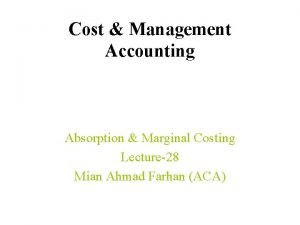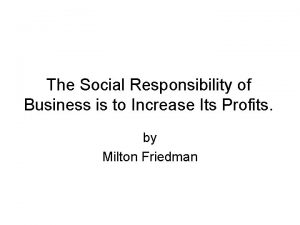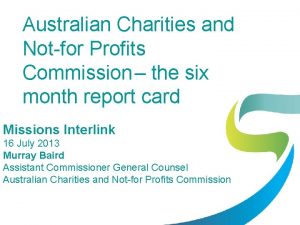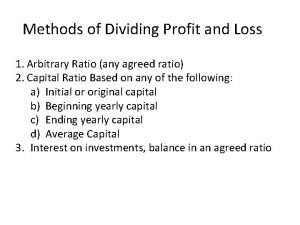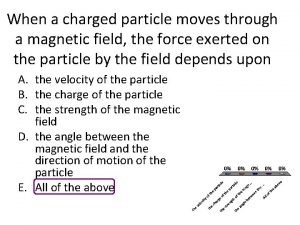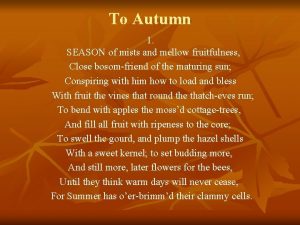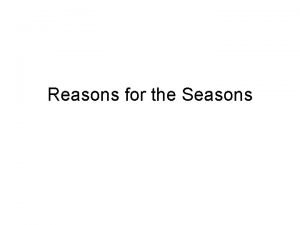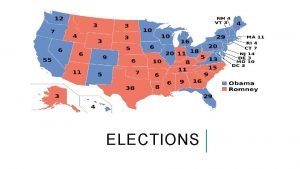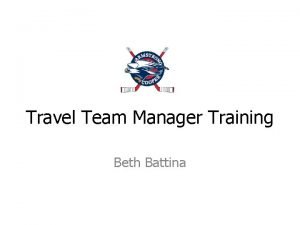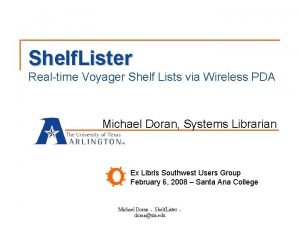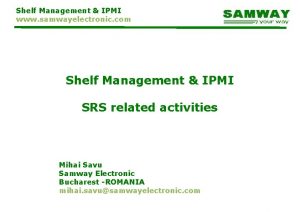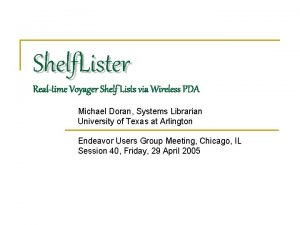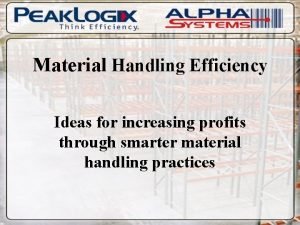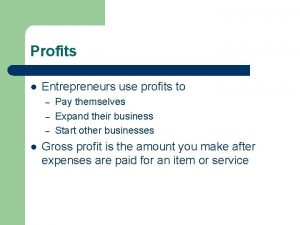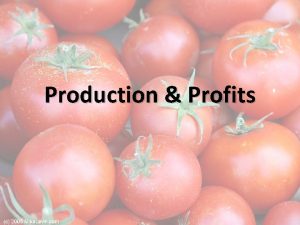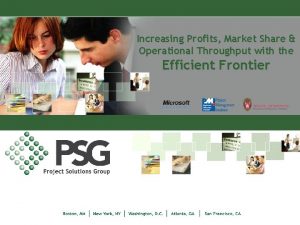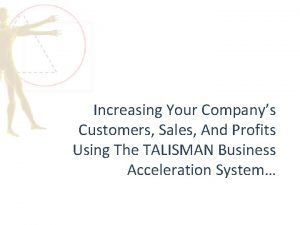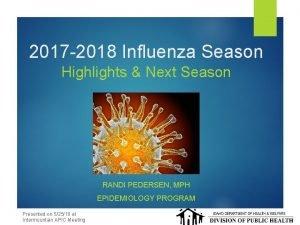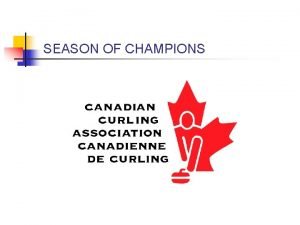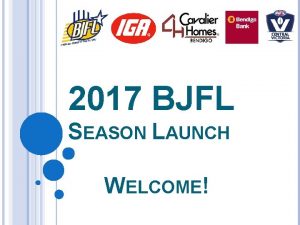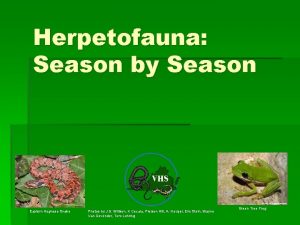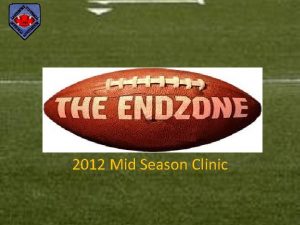From Field to Shelf Increasing Profits Through Season




























- Slides: 28

From Field to Shelf: Increasing Profits Through Season Extension and Diversification by Adding Value to Your Farm Products – Which Food Safety Principles Apply? Amanda J. Kinchla Associate Extension Professor Food Science Department UMASS, Amherst Kinchla@umass. edu https: //www. ciderculture. com/juicing-systems-cider-pressing-equipment-history/

Click “View Options” and then annotate the next slide, you can use a stamp to show on the map where you are located! Here is where you can turn on or off your camera and microphone Click this ”Chat” button to ask a question during the presentation

Other Please use the “annotate” feature to mark where your facility is located on the map 3 Northeast States Labelling – Pinterest. com – Mrs. S’s Class

Why value-add? • Helps extend production season • Reduces waste • Surplus • Non-wholesale This Photo by Unknown Author is licensed under CC BY-NC-ND • Increases revenue • Introduces new markets This Photo by Unknown Author is licensed under CC BYNC-ND

Regulation: Retail vs. Wholesale Retail • Restricted to sales directly to the consumer, and are inspected and licensed by the local board of health. • General consuming public (small portion) • Food Code https: //www. fda. gov/food/fdafood-code/state-retail-and-foodservice-codes-and-regulationsstate Wholesale • Sold to wholesalers, retailers, and industrial or business purchasers (large quantity) • Wholesale operations may sell their products to retail stores, restaurants, etc. , and are inspected and licensed by the Massachusetts Food Protection Program. • 2 Regulating bodies • USDA – 9 CFR • FDA – 21 CFR

What Foods May Be Produced in A Residential Kitchen? • Retail Residential Kitchen - only “Cottage Food Products. ” • Non-Potentially Hazardous – • Safely held at room temperature, • I. e. baked goods, jams, and jellies. 105 CMR 590. 001(C); FC 1 -201. 10 (B) • Check your local boards of health regulations • Wholesale Residential Kitchen - produce foods that can be safely held at room temperature and foods that do not require refrigeration Retail or Wholesale Residential Kitchens may not prepare finished products that require hot or cold holding for safety. Examples Include: Meat, poultry, fish, juice, canned foods, cut produce, infused vinegars, sauces, prepared meals and more. https: //www. mass. gov/info-details/residential-kitchen-questions-and-answers#what-is-a-residential-kitchen? -

Can I make this in a residential kitchen? This Photo by Unknown Author is licensed under CC BY No. The preparation of frozen peas requires temperature control to ensure proper safety.

Can I make this in a residential kitchen? This Photo by Unknown Author is licensed under CC BY-NC-ND Yes! The natural sugars in the fruit plus added sugar and water bath canning help to make this product shelf stable. NOTE: Control Brix.

Can I make this in a residential kitchen? This Photo by Unknown Author is licensed under CC BY-NC-ND No. The p. H and processing conditions must be monitored to ensure food safety. NOTE: Low acid and canned foods require a scheduled process issued by a process authority.

FSMA Food Safety Modernization Act Accredited 3 rd Party Certification Rule 21 CFR Subpart M Preventative Controls Human Food Rule and GMP 21 CFR 117 Produce Safety Standard Rule 21 CFR 112 Preventative Controls Animal Food 21 CFR 507 Foreign Supplier Intentional Sanitary Verification Adulteration Transport Program Rule 21 (Food Human & CFR Subpart L Defense) 21 Animal Food 21 CFR 121. 1 CFR Subpart O 10

Food Safety Regulation and Processing Food Safety HACCP Meat & poultry 9 CFR 304 Juice Seafood Low Acid 21 CFR 101/102 21 CFR 123 21 CFR 113 AND Preventive Controls Preventative Controls *Dairy – also PMO *Acidified – also comply with 21 CFR 114 11

Preventive Controls: What are they? • Preventive Controls are procedures you implement to reduce or remove hazards that are found in your food product at your facility • There are four categories: • Process Preventive Control • Allergen Preventive Control • Sanitation Preventive Control • Supply chain Preventive Control 12

Contents of a Food Safety Plan Required • Hazard analysis • Preventive controls* • Process, food allergen, sanitation, supply-chain and other • Recall plan* Useful • Facility overview and Food Safety Team • Product description • Flow diagram • Process description • Procedures for monitoring, corrective action and verification* Chapter 2, Food Safety Plan Overview for Preventive Controls for Human Food, slide 19 * Required when a hazard requiring a preventive control is identified 13

Hazard Analysis The first step of creating a FSP is conducting a hazard analysis: 1. List Ingredient/processing steps 2. Identify potential food safety hazards 3. Determine if hazard requires a PC 4. Justify Decision 5. Identify preventive controls for significant hazard 6. Double check preventive control has been implemented 14

Potential Preventive Controls Examples • Biological Hazards • Process controls that kill pathogens • E. g. Cooking • Process controls that prevent growth; e. g. • Time/temperature controls • Checking formulation • Supply-chain programs for sensitive ingredients used without a kill step • Sanitation Controls that prevent recontamination Chemical Hazards • Supply-chain programs • Allergen Labeling • Sanitation controls to prevent allergen cross-contact Physical Hazards • Process Controls such as • Filtering, metal detection, Xray devices 15

Hazard Analysis Example Hazard Analysis PRODUCT: Prepared Frozen Omelet PAGE X of Y PLANT NAME Joe’s Famous Breakfasts Facility ISSUE DATE mm/dd/yy ADDRESS 1000 Main St, Amherst MA USA SUPERSEDES mm/dd/yy (1) Ingredient/ Processing Step (2) Identify potential food safety hazards introduced, controlled or enhanced at this step (3) Do any potential food safety hazards require a preventive control? Yes Biological Hazards B Chemical Hazards C Physical Hazards P No (4) Justify your decision for column 3 (5) What preventive control measure(s) can be applied to significantly minimize or prevent the food safety hazard? Process including CCPs, Allergen, Sanitation, Supplychain, other preventive control (6) Is the preventive control applied at this step? Yes No 16 FSPCA – Hazard Analysis and Preventive Controls Determination for Human Food

Hazard Analysis Prepared Frozen Omelet PLANT NAME Joe’s Famous Breakfasts Facility ISSUE DATE mm/dd/yy ADDRESS 1000 Main St, Amherst MA USA SUPERSEDES mm/dd/yy (1) Ingredient/ Processing Step (2) (3) Identify potential Do any food safety hazards potential food introduced, safety hazards controlled or require a enhanced at this step preventive control? Yes B Vegetative Receiving refrigerated pathogens ingredients – such as liquid Salmonella pasteurized egg C Allergen – egg, P None PAGE X of Y (4) Justify your decision for column 3 (5) (6) What preventive control measure(s) Is the can be applied to significantly preventive minimize or prevent the food safety control applied hazard? at this step? Process including CCPs, Allergen, Sanitation, Supply-chain, other preventive control No Yes X While pasteurization minimizes the likelihood of Salmonella USDA recommends the product be used in cooked foods. Experience has shown Salmonella occasionally occurs in this ingredient. X Egg is an allergen that must be labeled to inform consumers. Cross-contact is not an issue – all products contain egg. X FSPCA – Hazard Analysis and Preventive Controls Determination for Human Food No Process Control - subsequent cook step X Allergen Control – allergen labeling at other steps X 17

Modified Requirements • Read this article to check if you fall under the qualified individual category: • Guidance for Industry: Determination of Status as a Qualified Facility • Where to find attestation forms online – FDA Website • Having a food safety plan is relevant! You want to assure that risks in the facility are being addressed properly. https: //www. fda. gov/food/registration-food-facilities-and-other-submissions/qualified-facilityattestation 18

GMPs • Current Good Manufacturing Practices 21 CFR Part 117 • Personnel • Plant and grounds • Sanitary operations • Sanitary facilities and control • Equipment and utensils • Processes and controls • Warehousing and distribution • Holding/distribution of human byproducts for animal use • Natural or unavoidable defects that present no health hazard 22 http: //www. fpsa. org/wp-content/uploads/CFR-110 -vs-117. pdf https: //www. centurylabel. com/news/2016/9/8/cmc-groupscentury-label-division-achieves-gmp-certification 19

Legal & Financial Implications - Recalls • Recalls are actions taken to remove an adulterated, misbranded, or violative product from the market. • If there is a hazard in your facility or with your product, you MUST have a recall plan! üYour liability üYour customers üYour reputation üThe local food system 20

Record Keeping • Records used to document that food safety hazards have been controlled by preventive controls • Accurate record keeping provides documentation that food safety hazards are being controlled. • Information required: • Standard information required • Signature or initials of the person reviewing the record, and date of the review • Cost and risk considerations 21

Food Safety Recommendations: Where Do I Start? • Implement/Develop/Maintain GMPs • Set up a documentation system for critical control points in your operating procedures (SOPs) • Develop written ingredient and packaging material specifications developed for all suppliers, and verification of compliance with those suppliers. • Sanitation Controls – recommended cleaning products to be used during manufacturing • Audit – will provide recommendations for improvement* 22

Key Points for Preventive Controls • FSMA - “Directs the Food and Drug Administration (FDA) as the food regulatory agency of the U. S. Department of Health and Human Services to better protect public health by, among other things, adopting a modern, preventive, and risk-based approach to food safety regulation. ” • Preventive controls fall under FSMA • Should have plan by January 2020 if you’re a qualified facility • If your product falls under the modified qualifications, understand file for attestation 23

Key Points for Preventive Controls • Key core components of FSP/Preventive Controls • Hazard Analysis • Preventive Controls* • Monitoring • Corrective Actions • Verifications and Associated Records • Developing a food safety plan will help you and your staff understand the risks and significantly reduce food-related incidents. 24

Personnel • Consultants and auditors • Process authorities and subject matter experts • University specialists • Government agencies • Trade associations • Suppliers, buyers, laboratory analysts 25

Trusted Internet Sites and FDA Guidance • FSPCA, FDA Website, Trade Association Websites, USDA Website • In Development: Food Safety Preventive Controls for Human Food Hazards and Controls Guidance* • Seafood HACCP Hazards and Controls Guidance • Juice HACCP Hazards and Controls Guidance 26

Helpful Reminders • Don’t be alone in making your food safety plan! • Say what you do, do what you say • Hazards are okay! • Your safety plan is dynamic • Make a commitment to ensure food safety 27

Thank you! Amanda J. Kinchla Associate Extension Professor Food Science Department Kinchla@umass. edu • Successful Value Added Food Product Development: Managing Food Quality and Safety, March 23, 25 & 30 th from 9 AM-1 PM: • MDAR Food Entrepreneur Guide – coming this spring! • Resource leads for NPD: https: //ag. umass. edu/foodscience/resources
 In praise of profits
In praise of profits Jeevan kishore with profits
Jeevan kishore with profits Marginal cost format
Marginal cost format What misery to be wise when wisdom profits nothing
What misery to be wise when wisdom profits nothing The only responsibility of business is to maximize profits
The only responsibility of business is to maximize profits Australian charities and not-for-profits commission
Australian charities and not-for-profits commission Pest control profits
Pest control profits How to divide profit
How to divide profit Q factor of capacitor
Q factor of capacitor 21lwuy8i6hw -site:youtube.com
21lwuy8i6hw -site:youtube.com Waveguide cutoff frequency
Waveguide cutoff frequency Individual differences factors
Individual differences factors Data types and field properties
Data types and field properties Field dependent vs field independent
Field dependent vs field independent Magnetic field
Magnetic field Field dependent definition
Field dependent definition Square conductor
Square conductor A charged particle moves through a magnetic field
A charged particle moves through a magnetic field Disadvantages of tangential sawing
Disadvantages of tangential sawing Night of the scorpion poetry foundation
Night of the scorpion poetry foundation Through one man sin entered
Through one man sin entered Furcation classification
Furcation classification Autumn is a season of mellow
Autumn is a season of mellow Carver center for the arts and technology
Carver center for the arts and technology True or false questions about seasons
True or false questions about seasons Primary season 1
Primary season 1 Brooklyn hockey
Brooklyn hockey Warm season crops
Warm season crops Baseball league simulator
Baseball league simulator


